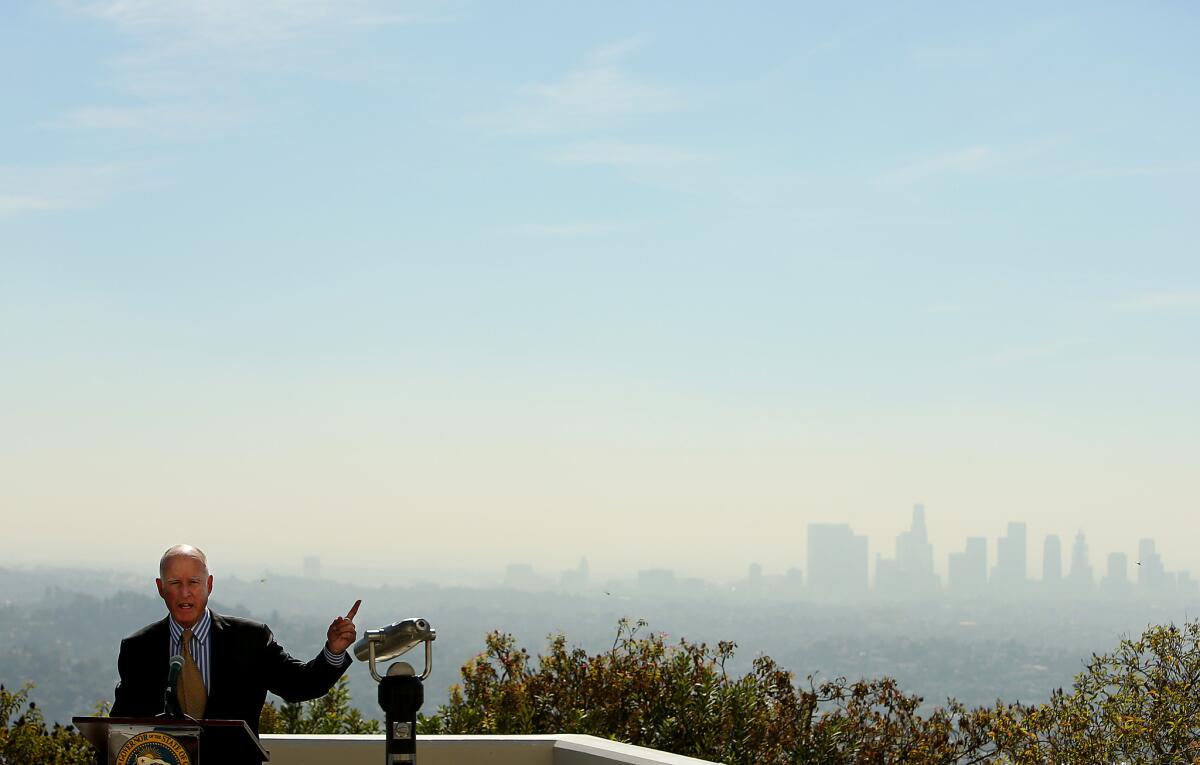Gov. Brown signs climate change bill to spur renewable energy, efficiency standards

Reporting from Los Angeles — California launched an ambitious effort Wednesday to expand renewable energy and increase energy efficiency, advancing Gov. Jerry Brown’s plans for battling climate change.
Brown signed the new goals into law at Griffith Observatory, where the panoramic view of smog across the Los Angeles Basin provided a reminder of the work to be done.
Although the state’s air quality has improved over the years, Brown said, more must be done to improve Californians’ health, and the state must continue setting the standard for halting global warming.
“We are talking about the big world of avoiding climate catastrophe, but we are talking about the immediate world of people living in Riverside, Los Angeles and other places,” Brown said. “This is big. It is big because it is global in scope, but it is also big because it is local in application.”
Under the legislation, which builds upon standards already on the books, California will need to generate half of its electricity from renewable sources such as solar and wind by 2030. At the same time, the state will need to double energy efficiency in homes, offices and factories.
Interested in campaigns and governing? Sign up for the free Essential Politics newsletter >>
A third goal, cutting gasoline use in half, was removed from the bill amid stiff opposition from oil companies and a failure to win enough support among Democrats. The debate dominated the final days of the legislative session last month, resulting in a defeat for Brown and the bill’s author, state Senate leader Kevin de León (D-Los Angeles).
Nevertheless, De León hailed the legislation as a landmark in California’s environmental efforts.
“We are doing away with the tired old stereotypes of environmentalism as a pastime of the wealthy and the elite,” De León said. “Soon, whether you live in Boyle Heights or Beverly Hills, Modesto or Marin, Sausalito or Santa Ana, Sacramento or Logan Heights, San Diego, you will have the same access to clean electricity and clean air.”
Besides the renewable energy and efficiency goals, the new law will make other changes to boost clean power.
It begins laying the groundwork for a regional electricity grid, which could make renewable energy more available throughout the West. And it creates incentives for utilities to install additional charging stations for electric vehicles, an effort to make drivers more comfortable shifting away from gasoline.
“Charging stations will be as ubiquitous as gas stations are,” De León said. “Now one industry can’t monopolize the transportation fuel supply.”
California is redoubling its environmental efforts less than three months before world leaders gather in Paris for a United Nations summit to create a new global pact for fighting climate change.
Brown said it would be an enormous challenge to shift the world away from the fossil fuels that have been the source of so much economic growth.
“This is going to be a long march to transition the entire modern world to a decarbonized future,” he said. “It’s important, and we’re doing it in California.”
The state’s new target for renewable energy is expected to stimulate the development of more solar and wind power plants. But it will also raise new challenges because renewable energy can be unreliable; it’s not always possible to predict when the sun will shine or the wind will blow.
Experts say California will need to invest in storage technology and other initiatives to ensure that the right amount of electricity is available when it’s needed.
“We have absolutely no doubt that we’ll be able to get there,” said Geisha Williams, president of electric operations at Pacific Gas & Electric, one of the state’s largest utilities. “We have a real opportunity to create a model that other states and nations can follow.”
Williams said it’s possible that the legislation could end up boosting electricity rates, but supporters say renewable energy prices are dropping and new efficiency targets would help keep bills stable overall.
The state will also need to become twice as energy efficient by 2030 under the new law. For existing buildings, that could include installing newer appliances or improving heating and air conditioning systems.
Andrew McAllister, a member of the California Energy Commission, said older apartment buildings would be particularly challenging.
“What we’re trying to do is facilitate, where necessary, the marketplace for energy efficiency, for building upgrades, for remodels,” he said.
Even though the goal of reducing gasoline use was not included in the final legislation, SB 350, Brown plans to use his executive power to keep working on the issue. Much of his authority rests with the Air Resources Board, a regulatory agency — a source of controversy during last month’s debate.
During Wednesday’s ceremony, Brown said he was glad the board was powerful. He joked, “I love the Legislature but I don’t want to entrust you with too much power.”
He said to lawmakers seated in the front row, “You can check in every now and then.”
De León, who has wanted more legislative oversight of air regulators, called out, “Quit while you’re ahead.”
“I will,” Brown responded. “I understand it’s a little bit of a controversy.”
Another bill awaiting the governor’s signature or veto would expand the Air Resources Board to include two more members, appointed by legislative leaders, to represent communities suffering from pollution.
Follow @chrismegerian for more updates from Sacramento.
For more political coverage, go to www.latimes.com/politics
ALSO:
Gov. Brown signs bill aimed at eliminating gender wage gap
California coroners have issues with new assisted death law
Gov. Jerry Brown approves new limits on paparazzi drones
More to Read
Get the L.A. Times Politics newsletter
Deeply reported insights into legislation, politics and policy from Sacramento, Washington and beyond. In your inbox three times per week.
You may occasionally receive promotional content from the Los Angeles Times.












